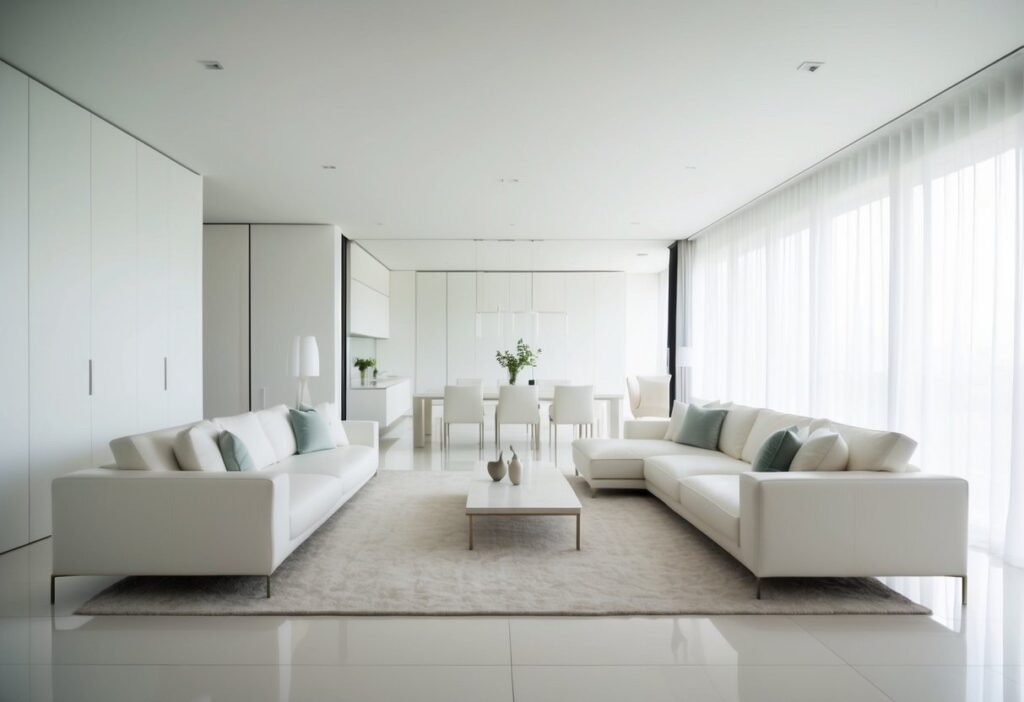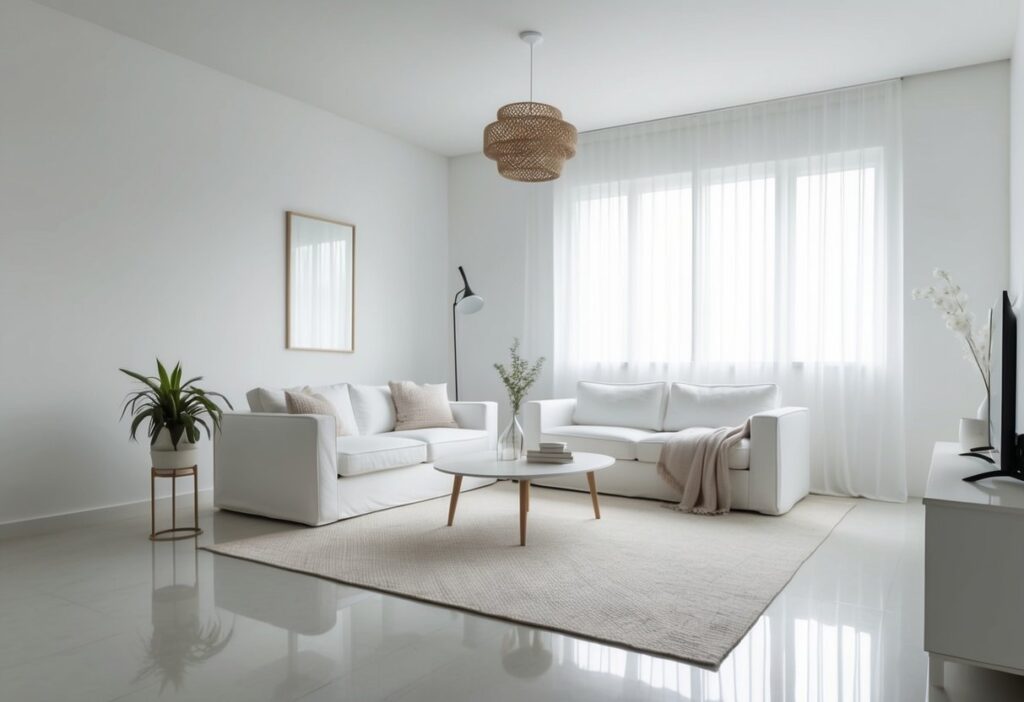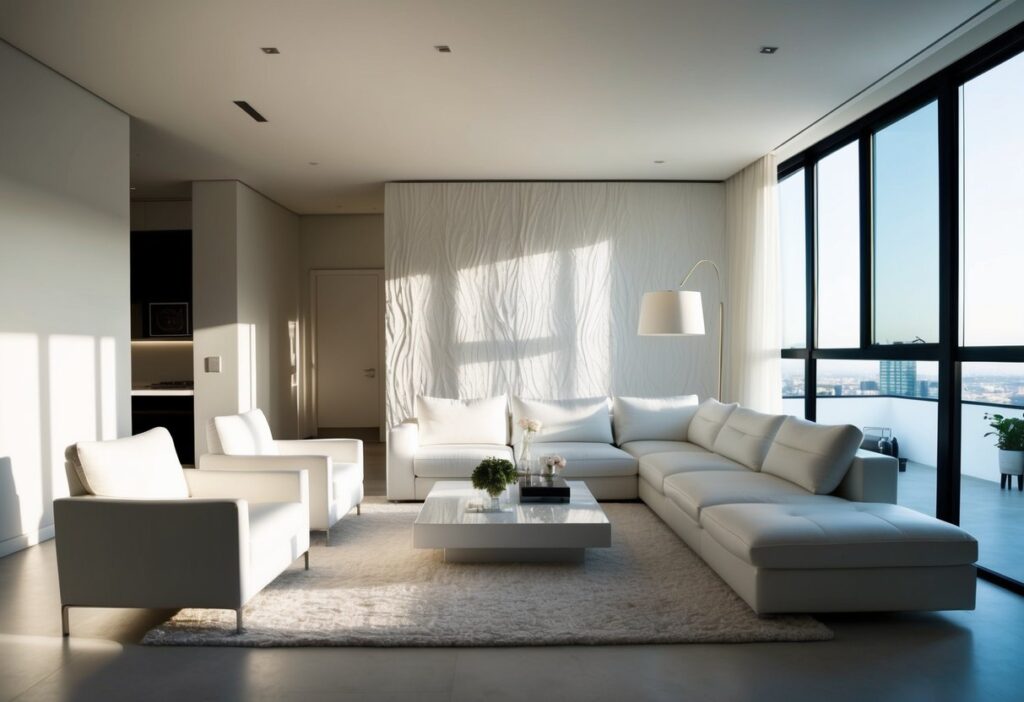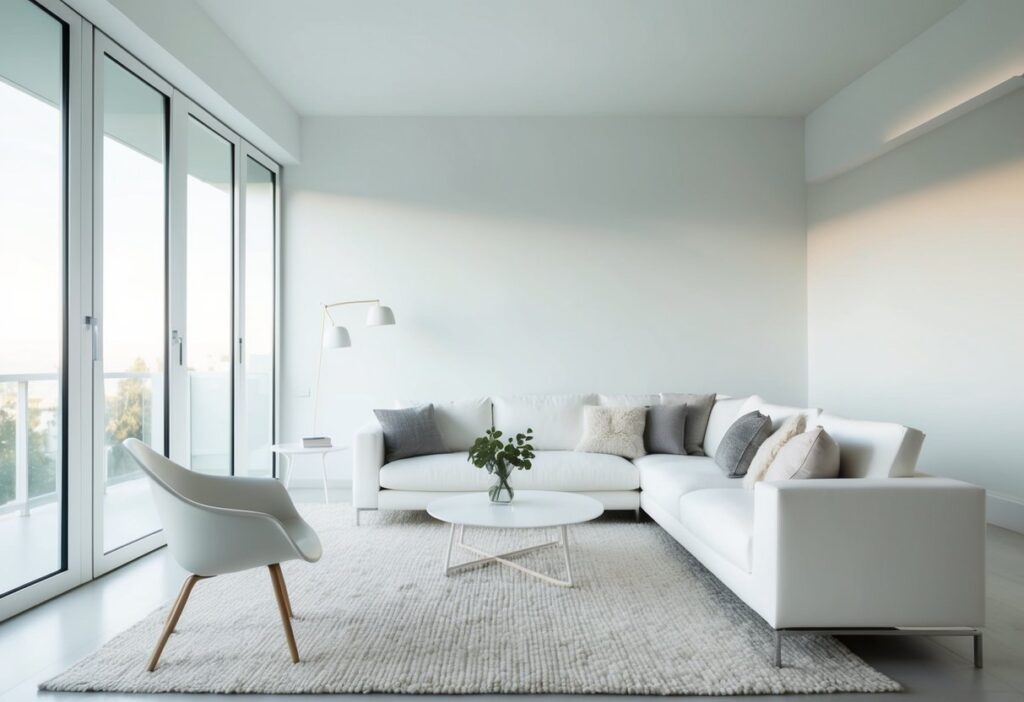The Power of White: Transforming Spaces with Stylish Simplicity
Using shades of white in modern design can unlock a fresh, clean, and sophisticated look for your space. White acts as a powerful tool in design, creating brightness and emphasizing your personal style through subtle accents and textures. With over 50 shades to choose from, the versatility is astounding. Whether you’re drawn to crisp whites or warmer, creamy tones, there’s a shade to match every mood and style preference.

Get the Fail-Safe Paint Color Playbook (Free PDF)
36 proven colors • 8 ready palettes • trim & sheen guide • printable testing cards.
Ever thought about how different lighting can change the look of a white room? In natural daylight, white can seem bright and airy, while at night, under artificial light, it might take on a cozier, more intimate feel. Playing with textures and forms, like pairing cube shelves with oval tables, can add depth and interest, making your space feel alive and dynamic.
Incorporating nature is another trick. Plants can break up the starkness of an all-white room, adding vibrancy and fresh energy. People like designer Stephanie Brown swear by whites like Benjamin Moore’s Oxford White for its ability to adapt to both modern and traditional settings. This flexibility allows you to experiment without fear of commitment. Ready to explore the world of white and transform your space? Let’s dive in and discover how these nuances can work wonders for your home!
White in Interior Design
White is a timeless choice in interior design, offering a clean slate for any room. It can create a sense of space and brightness, providing a perfect backdrop for other design elements. With the right approach, white can make your interiors feel both sophisticated and welcoming.
Building a White Palette
Creating a white palette is not just about picking a single shade. Over 50 shades of white exist, each with its nuances. It’s important to test out different whites in your space, considering factors like natural light and room size. Various shades can complement different textures and materials, creating depth in your design.
Tip: Use a mix of cool and warm whites to add dimension. Cool whites can lend a crisp feel, while warm whites bring a cozy vibe. Pair different whites with wood accents or soft furnishings for a harmonious look. Don’t forget that lighting changes how colors appear, so test your white palette under different light sources.
Playing with Textures
Textures can transform a white space from stark to inviting. Think of textures like your secret weapon. Combining materials such as rug, marble, and wood paneling adds interest and warmth.
A soft rug can cozy up any room, while marble provides a sleek contrast with its glossy finish. Wood paneling introduces a rustic touch, softening the harshness of stark white walls. Mix and match these elements to avoid a flat look. Ever thought of using a chunky knit throw or textured wallpaper? These small additions can dramatically change the feel of a white room, adding layers and richness.
Maximizing Natural Light
White reflects light, making a space feel larger and more open. In designs using a lot of white, natural light is your best friend. Large windows or skylights amplify this effect, creating a bright, airy atmosphere.
Mirrors are also useful for bouncing light around a room. Position them across from windows to double the effect. Even artificial lighting matters. Use LEDs or warm white bulbs to maintain consistency with your white decor. Remember to position lights strategically to highlight key features, like a beautiful art piece or a statement furniture piece.
Design Elements and Details

Get the Fail-Safe Paint Color Playbook (Free PDF)
36 proven colors • 8 ready palettes • trim & sheen guide • printable testing cards.
Designing with white allows you to express creativity through various elements. You can use metallics to add elegance and incorporate greenery to infuse life and vibrancy. These details enhance the aesthetic of any space.
Incorporating Metallics
Metallics can add a touch of luxury and sophistication to your design. Imagine a white room with a shiny gold vase or a sleek silver-framed mirror. These elements reflect light and bring an air of elegance. An accent wall with metallics can serve as a focal point, drawing attention and adding depth.
Get the Fail-Safe Paint Color Playbook (Free PDF)
36 proven colors • 8 ready palettes • trim & sheen guide • printable testing cards.
Incorporate small metallic touches through table lamps, cushion trims, or even gallery wall frames. Pairing warm metallics like gold or brass with cool white tones can create a striking contrast. Consider mixing different metals to add variety without overwhelming the senses. This combination can ensure a balanced, stylish look.
Utilizing Greenery
Adding greenery is a simple yet effective way to liven up a white space. Plants introduce texture and color, breaking the monotony of white interiors. Even a small potted plant can make a big impact, offering a fresh, earthy feel. Hanging plants or architectural details like living walls can add depth and interest.
Consider placing greenery near windows to let natural light highlight their beauty. Climbing plants or vertical gardens can be fantastic options if you’re short on space. Mirrors can double the visual impact by reflecting greenery, creating the illusion of a larger, vibrant area. This infusion of nature softens the space and provides a sense of tranquility.
Color Dynamics in White Spaces

Using shades of white in design can provide a clean and spacious feel while also offering an opportunity to play with color dynamics. Whether you want to break the monotony with pops of color or create a cohesive theme, the choices you make will impact the overall atmosphere of your space.
Adding Pops of Color
In an all-white space, adding pops of color can create a refreshing contrast. This technique not only breaks the uniform look of white but also draws attention to specific elements. Think about adding bright cushions, a colorful rug, or even a statement art piece.
Why do pops of color work so well? They grab attention! Imagine a vibrant orange vase on a white table; it becomes the star of the room. A little color adds personality, making the space unique. Choose colors that reflect your personal style and make the room feel more inviting.
Pairing white with bold colors, like navy or emerald green, can also add elegance. Small changes, like a brightly colored coffee table book or a vivid lampshade, can make a big difference. The key is moderation—don’t overdo it, or the magic might fizzle out.
Choosing a Theme
Picking a theme for your white space can guide your color choices and make decorating easier. A cohesive theme helps to create harmony in your home. Do you want a minimalist look? Stick to neutral shades with soft textures. For a coastal vibe, incorporate light blues and sandy beiges.
A theme can also be fun! If you’re into vintage aesthetics, splash some pastel colors around. Maybe you’re more industrial? Add some metal accents with white. By defining a theme, every choice you make will contribute to the overall feel of the space.
Using a color theme ensures that your design elements complement each other. This method makes it easier to shop for décor while ensuring everything feels intentional. Remember, your home should reflect who you are, so choose a theme that resonates with you.
Get the Fail-Safe Paint Color Playbook (Free PDF)
36 proven colors • 8 ready palettes • trim & sheen guide • printable testing cards.
Furniture and Decor
Decorating with white can create a clean and serene vibe in your home. Choosing the right furniture and adopting a minimalist approach will ensure a stylish and airy look. Let’s explore how to make the most of white furniture and minimalist design.
White Furniture Selection
Choosing white furniture for your space isn’t just about picking any white item. It’s about selecting pieces that blend well with your room’s lighting and existing decor. Light bounces beautifully off white surfaces, making your space appear larger and brighter. A white sofa can be the focal point of your living room, paired with a soft white rug.
Consider different textures to avoid a sterile look. Mix glossy white tables with matte or textured cushions. Layering textures brings depth and warmth. Use different shades of white, like ivory or cream, to add variety. When selecting materials, white wood or metal pieces can add an elegant touch.
Minimalist Approach
The minimalist design emphasizes clean lines and simple shapes, and it’s perfect for amplifying the beauty of white furniture. Think about multi-functional furniture to keep your space clutter-free. A white storage ottoman, for example, offers both seating and storage.
Stick to a limited color palette. It’s not only calming but makes the space look seamless. Minimalist decor enhances this harmony while highlighting the serenity of white tones. Keep surfaces clear, only displaying items that serve a purpose or bring joy. Remember, less is often more. Select minimalist artwork or plants to complement the white furniture without overwhelming the space.
Connotations of White

Get the Fail-Safe Paint Color Playbook (Free PDF)
36 proven colors • 8 ready palettes • trim & sheen guide • printable testing cards.
White carries a range of meanings, from purity and innocence to cooler, more serene emotions. Understanding how different shades can impact mood and perception adds a fascinating layer to its use in design.
Symbolism of White
White often symbolizes purity and cleanliness. Think of a snowy landscape or a crisp white shirt—these images evoke feelings of freshness and simplicity. In many cultures, white is linked to peace and new beginnings, like in weddings where it represents innocence and new starts.
This color also stands for clarity and calm. It’s frequently used in spaces that need to feel open and airy. You’ll often find it in hospitals and clinics because it suggests sterility and order. Its neutral stance makes it adaptable across styles.
Get the Fail-Safe Paint Color Playbook (Free PDF)
36 proven colors • 8 ready palettes • trim & sheen guide • printable testing cards.
Shades and Meanings
Not all whites are the same; different shades bring varied meanings. Antique white is warm and inviting, perfect for creating cozy rooms. Meanwhile, ivory adds a touch of elegance due to its creamy undertones. This makes it ideal for places that aim to feel welcoming yet sophisticated.
Snow white is the go-to for clean and modern spaces. It reflects light well, adding a sense of space and brightness to any room. Meanwhile, off-whites like cream carry subtler tones that maintain the charm without overwhelming a space. Each shade offers unique emotional cues, enhancing the mood of your design.
